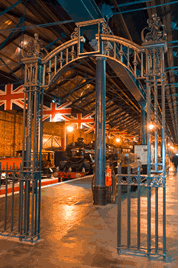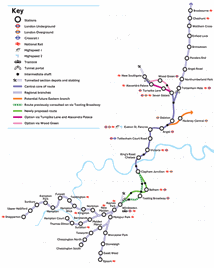 Read the peer reviews for this feature.
Read the peer reviews for this feature.
Download the graphs for this feature.
The symbolism of choosing the National Railway Museum as the venue for the launch of the National Infrastructure Commission (NIC) on October 30 reflected both the current levels of investment in the railway and one of the NIC’s three specific projects - to examine how the North’s needs can best be met.
The two other strands in the terms of reference are energy infrastructure and to examine the road, rail and underground needs of London. Chancellor George Osborne and NIC Chairman Andrew Adonis talked about the Commission’s role in overseeing the promised £100 billion investment in infrastructure by 2020, and Osborne announced that large investment projects would be at the heart of the November Autumn Statement and Spending Review.
But what is the background to the NIC, and how well conceived is its remit? Many who read the terms of reference might have been surprised at how thin they are - without their repetitiveness, they would have been even shorter, and they raise more questions than provide answers.
The idea was taken from Labour’s plans for an identically named NIC that were drawn up by Sir John Armitt, who is one of the seven commissioners on the NIC. Labour envisaged a more overarching role not confined to specific proposals or geographical areas, and its deliberations were to take account of a broader context. For example, it was to take into consideration population trends, modal integration, the environment and climate change.
Taking the North first, the NIC will work with the Department for Transport, Network Rail and Transport for the North, which will be producing an updated Northern Transport Strategy by Budget 2016. It is charged with identifying “options for long-term transport investment… that will improve connectivity between cities, form a single northern economy and drive economic growth”, looking particularly at east-west corridors.
The NIC will build on that, looking at gaps, the growth drivers and constraints, and ways to increase benefits and reduce costs, over a 20 to 30-year time frame. The recommendations will be stress-tested under three affordability scenarios, and the deadline for the report is Budget 2016.
In looking at the strategic options for London, the NIC will be working with Transport for London and NR on a blanker canvas, apart from Crossrail 2. The terms of reference are similar to those applied to the North, except for the gnomic injunction to “consider the potential impact of both Crossrail 2 and other strategic options for employment, productivity and housing supply in London and the South East”. Recommending the next steps from that cat’s cradle by Budget 2016 will be a challenge.
Funding will obviously be at the heart of the NIC’s conclusions. Osborne expects asset sales to fund part of the planned spending, but the options are certain to be constrained by the Charter for Budget Responsibility requiring the public finances to be in overall budget surplus by 2019/20. Given the almost monthly revisions to progress reports on that goal, one wonders how much value there is to stress-testing the NIC’s proposals for affordability over a 20 to 30-year period.
A unique criterion of the London evaluation is to consider “options for funding and financing in a way that minimises the taxpayer burden, and ensures those that benefit most bear a fair share of the cost”. Will that encourage ideas of wider road user charges? Will it factor in the colossal health costs of London’s traffic-induced pollution, or the costs of congestion?
Transport investment in the capital will arguably have a greater impact on the quality of life for its residents and workforce than any other government intervention. Yet there is nothing in the NIC’s terms of reference to focus investment on schemes that will encourage the use of the only sustainable mode capable of meeting the needs of a city with a population expected to top ten million within 15 years.
There are other unanswered questions:
- How does the NIC’s work dovetail with the Treasury’s National Infrastructure Plan (RailReview Q2-2015)?
- Will projects be determined by top-down decisions with limited consultation, or will the opinions of end users be canvassed?
- Will the NIC be delving into the myriad small-scale projects that can produce benefits out of all proportion to their cost: the passing loop on the Falmouth branch that transformed the service and generated a 208% passenger increase in ten years; the Todmorden curve; the incremental schemes to improve the Felixstowe-Nuneaton freight corridor?
On the same day as the Autumn Statement was delivered, the Bowe Review into the planning of Network Rail’s Enhancements Programme 2014-2019 was published. Dame Colette Bowe’s report highlighted the need for long-term visibility of an infrastructure programme if the supply chain was to overcome the capacity constraints (particularly in signalling and electrification) that had undermined progress with current enhancements. It also warned of the risks inherent in a lack of “whole system thinking” and failing to integrate infrastructure planning with rolling stock choices and franchising.
Passenger engagement
The Bowe Review also implied a challenge for the NIC consultation process by pointing out “the importance of passenger engagement in scheme selection” in infrastructure planning, and that “Route Utilisation Strategies were drawn up with input from local user groups, as well as Transport Focus and operators - passenger, freight and open access”. The limited time given for the NIC’s recommendations will make it difficult to adhere to these precepts.
The Autumn Statement and Spending Review on November 25 contained no surprises, although the £150 million funding for delivery of smart and integrated ticketing across rail, tram and bus services in the North was announced. Some £15.8 billion was earmarked for high-speed rail, and £20m was allocated to the New Stations Fund, mentioning a new station between Castle Cary and Taunton. Otherwise, the statement listed existing projects.
The railway cannot complain about the figures. Total rail spending including high speed in 2015-20 is budgeted at £50.3bn, compared with £22.6bn on roads, plus £0.5bn for the Local Sustainable Transport Fund. This implies a desire to move to a more sustainable balance and reduce carbon emissions, as does the commitment to freeze rail fare increases at no more than inflation (RPI) until 2020. This will do little more than moderate a widening gap in the costs for rail and road users. It has been government policy to make rail users pay a higher proportion of costs - the consequence has been a real-terms increase in rail fares of 63% between 1980 and 2014 compared with a fall of 14% in the cost of motoring, according to the Office for National Statistics.












